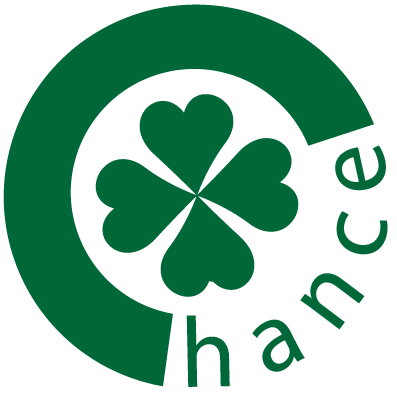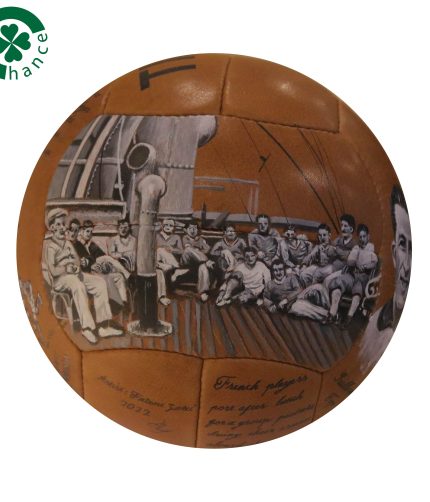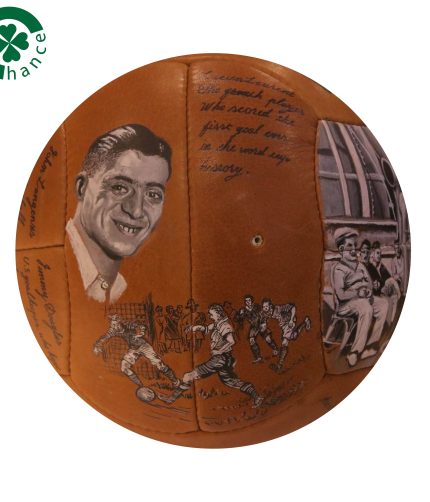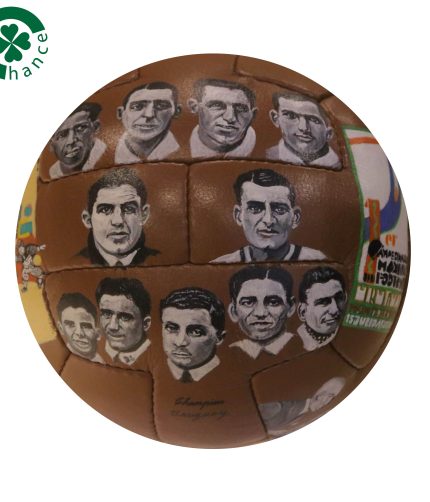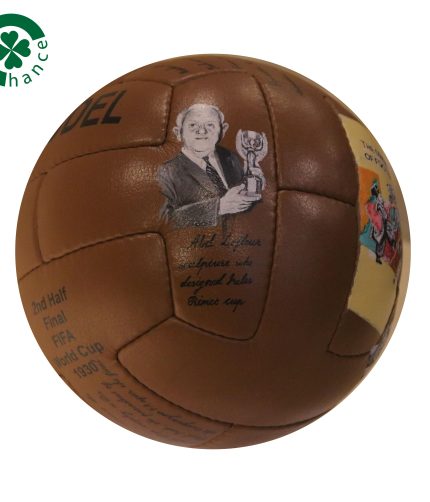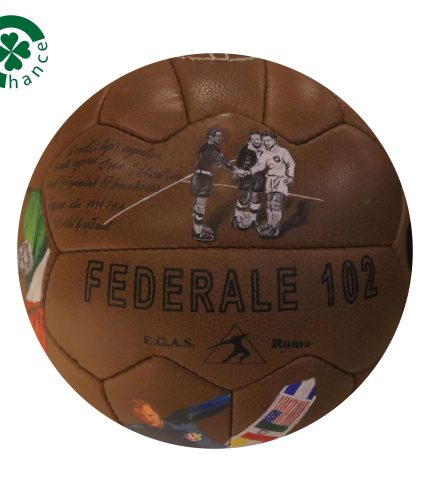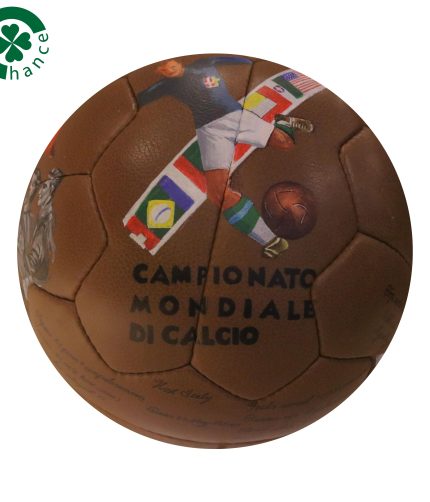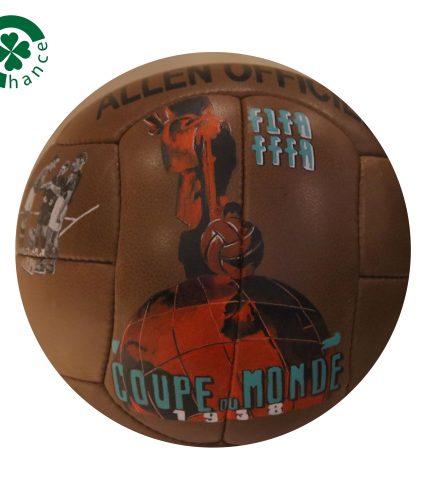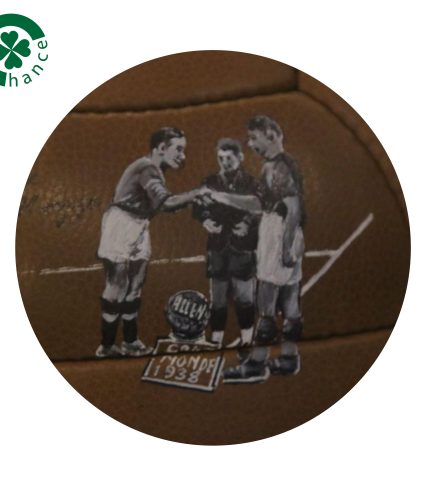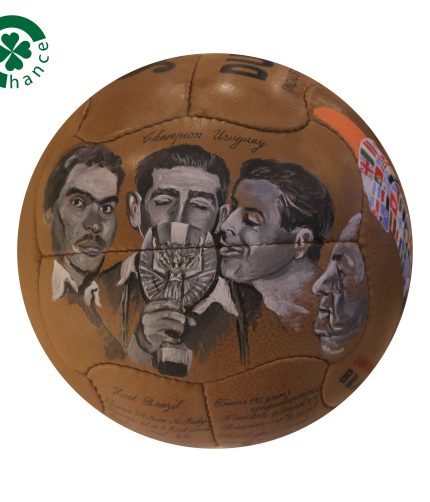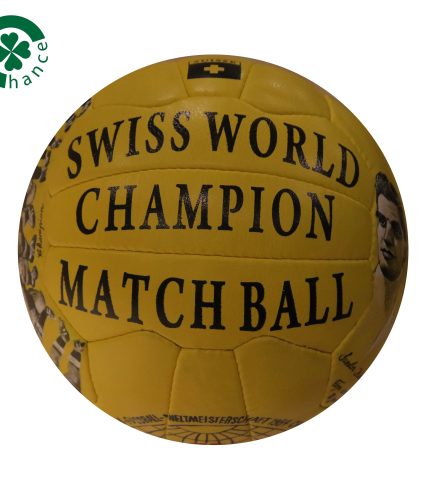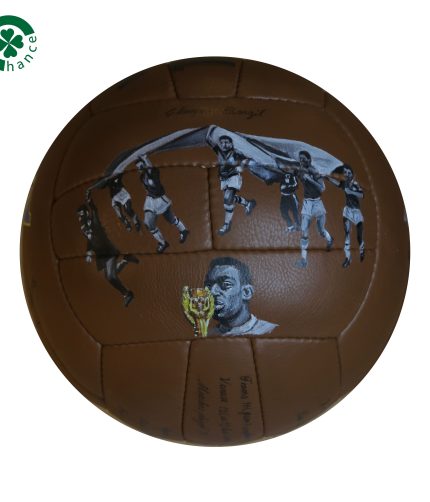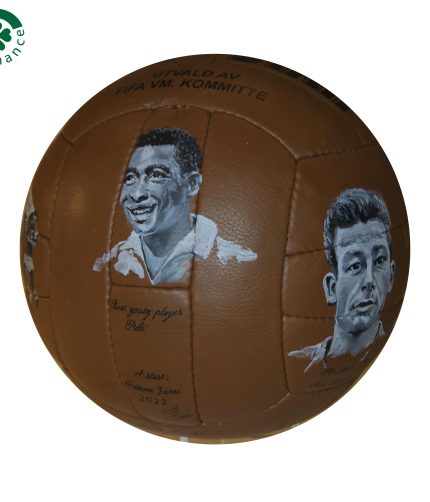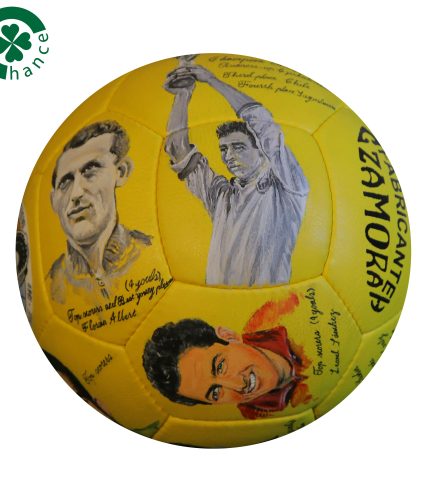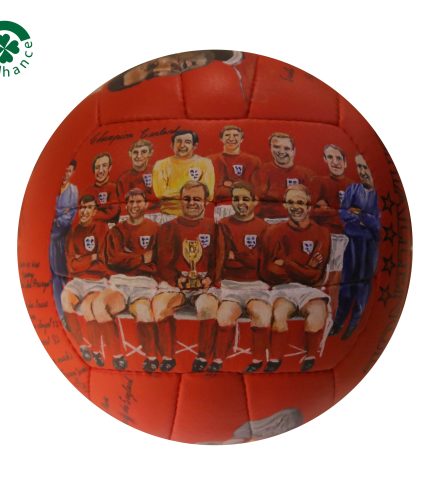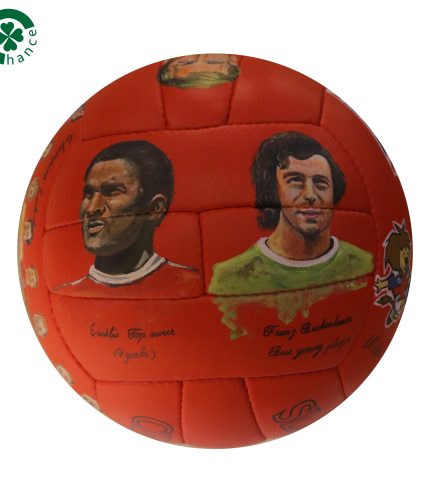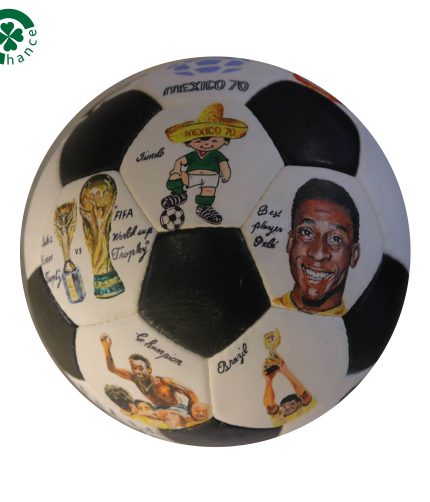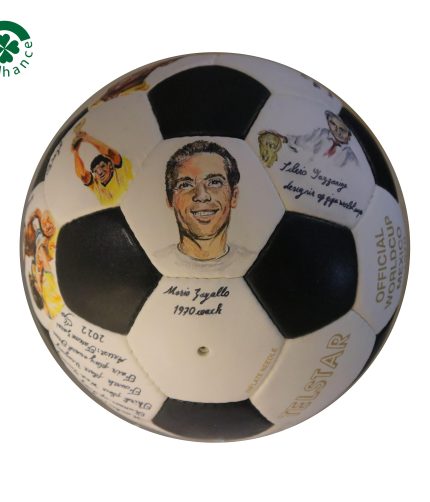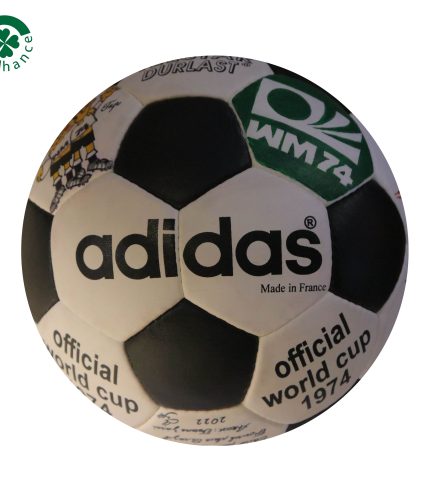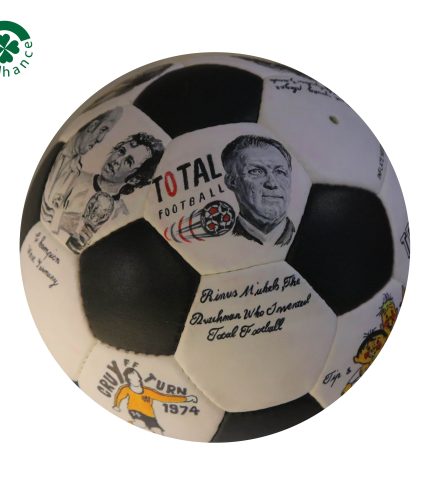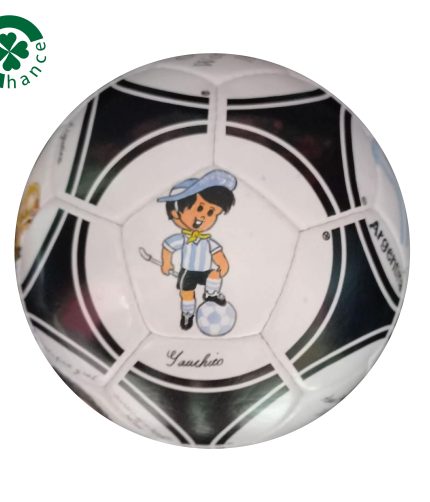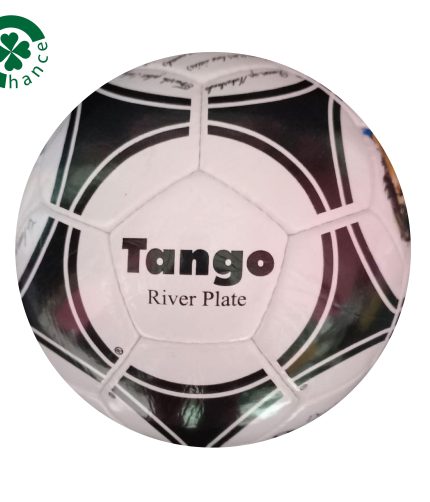1930 World Cup Painted Ball – Argentina Ball
Product Name : 1930 World Cup Painted Ball – Argentina Ball
Date of Registration : 02/01/2023
Category Art : Painting
Art Field : Visual Arts
Total Production : One Collection with Twenty Three Balls
Production Year : 2022
Art Style : Acrylic
Ball Name : Tiento
Artist Name : Fatemeh Zarei
Size : 5
Weight (gr) : 380 – 410
Has a signature : Yes
Materials :
This vintage leather football ball with lace in made by John Woodbridge with 12 panels. A leather rigorously selected for its quality. Hand sewn, it is manufactured in the respect of the traditional techniques. Its hand-made patina gives it a unique style, a retro and elegant look that will delight collectors and old school sports objects lovers.
About Tiento :
two different balls were used in the final: Argentina supplied the first-half ball (the ‘Tiento’) and led 2–1 at the break; hosts Uruguay supplied the second-half ball (the ‘T-Model’ which was larger and heavier)[4] and won 4–2.
1930 World Cup Painted Ball – Uruguay Ball
Product Name : 1930 World Cup Painted Ball – Uruguay Ball
Date of Registration : 02/01/2023
Category Art : Painting
Art Field : Visual Arts
Total Production : One Collection with Twenty Three Balls
Production Year : 2022
Art Style : Acrylic
Ball Name : T-Model
Artist Name : Fatemeh Zarei
Size : 5
Weight (gr) : 380 – 410
Has a signature : Yes
Materials :
Vintage leather football with 10 panels, this “T-shaped” ball is a replica of one of the most famous models of history. Handmade with Woodbridge “savoir-faire”, its patina give it an authentic old school and unique style.
An iconic model in football history, the “T-shape” is the ball that helped Uruguay win the inaugural edition of the World Cup. While the first half of the tournament final was played with the Argentinian favorite ball, Tiento, Celeste approached the second act with a goal behind, led 2 to 1. More comfortable with his An English-made T-shaped panel model, the host country team found the net three times to lift the Jules Rimet Trophy in front of the 70,000 spectators at the Centenario Stadium in Montevideo. On July 30, 1930 at 3.30 p.m., John Langenus, the Belgian referee of the match, entered the field with a ball under each arm in order not to favor either of the two nations. A unique event in the history of the round ball.
About T-Model :
Inspired by the famous “T-Shape” design used in the second half of the 1930 World Cup Final, with which the Uruguayan team won the very first edition of the most popular sports competition with a final score of 4-2 against Argentine, the John Woodbridge 1930 T-shape vintage football.
1934 World Cup Painted Ball
Product Name : 1934 World Cup Painted Ball
Date of Registration : 02/01/2023
Category Art : Painting
Art Field : Visual Arts
Total Production : One Collection with Twenty Three Balls
Production Year : 2022
Art Style : Acrylic
Ball Name : The Federale 102
Artist Name : Fatemeh Zarei
Size : 5
Weight (gr) : 380 – 420
Has a signature : Yes
Materials :
The Federale 102 ball was composed by 13 polygonal panels which were cut and perfectly fitted together by hand sewing. Most of the classic balls at that time were 12 panel models (like the ones used 4 years ago in the first World Cup) but the Federale 102 brought an invention of having the laces on a separate panel to inflate the balls. The bladder was enclosed by lace with 6 rows. For the very first time the leather laces of a World Cup ball were replaced by brown cotton,very similar to the ones used on shoes. This represents a small detail but an important improvement, as well. As cotton is much softer than any leather,this encouraged players to head the ball more.
About The Federale 102 :
As the second World Cup was approaching,the fascist regime of Mussolini became so powerful that Italy was chosen to be the host of the 1934 FIFA World Cup.The strong nationalism requested that the balls used in the tournament had to be produced in Italy. In the beginning of the 20th century the majority of footballs were made in Britain and were exported to different countr ies where footba ll became more and more popular and equipment was badly needed. But as previously mentioned, the Italian political power insisted on using Italian made balls for the first World Cup to be hosted in Europe.
1938 World Cup Painted Ball
Product Name : 1938 World Cup Painted Ball
Date of Registration : 02/01/2023
Category Art : Painting
Art Field : Visual Arts
Total Production : One Collection with Twenty Three Balls
Production Year : 2022
Art Style : Acrylic
Ball Name : Allen
Artist Name : Fatemeh Zarei
Size : 5
Weight (gr) : 380 – 386
Has a signature : Yes
Materials :
The Allen ball was very similar to the Federale 102 (the official ball of the previous World Cup) because it also consisted of 13 panels. However, the edges of the panels of the Allen ball were much more rounded so the overall design was not completely the same as the Italian ball four years earlier. The Allen ball was much more like the Globe and the Players balls from the 1930 World Cup. However, the manufacturer maintained the developments of the Federale 102 and the laces were put on a separate, thin panel. Black and white pictures prove that the cotton laces of the Allen balls were white, however, this was not a long lasting colour, since the rain and mud immediately changed the colour of the laces to brown. This ball was hand sewn just like its predecessors and had to be inflated by a skilled person. If the man who inflated the ball and closed the laces was not precise, the ball did not become spherical which would influence the trajectory of the ball.
The 1938 FIFA World Cup was the third edition of the World Cup, the quadrennial international football championship for senior men’s national teams and was held in France from 4 June until 19 June 1938. Italy defended its title in the final, beating Hungary 4–2. Italy’s 1934 and 1938 teams hold the distinction of being the only men’s national team to win the World Cup multiple times under the same coach, Vittorio Pozzo. It would be the last World Cup until 1950 due to the disruption from World War II.
1950 World Cup Painted Ball
Product Name : 1950 World Cup Painted Ball
Date of Registration : 02/01/2023
Category Art : Painting
Art Field : Visual Arts
Total Production : One Collection with Twenty Three Balls
Production Year : 2022
Art Style : Acrylic
Ball Name : Superball Duplo T
Artist Name : Fatemeh Zarei
Size : 5
Weight (gr) : 355 – 404
Has a signature : Yes
Materials :
Created in the early 1930s by the brazilian industrials Luis Pole, Antonio Tossolini and Juan Valbonesi, the “Superball Duplo T” is selected to be the official football of the 1950 “Copa do Mundo” in Brazil. Consisting of 12 leather panels and an air chamber with inflation valve, the Duplo T innovates technically compared to older models by not having a lace, which makes it rounder, avoids false rebounds and injuries to the players. Called “Duplo T” in reference to its famous double inverted T-design, this is a new evolution towards the modern football ball as we know it today.
About Superball Duplo T :
he 1950 John Woodbridge football is inspired by the design used during the 1950 Brazilian FIFA World Cup called “Duplo T” by Superball. This ball is handmade using traditional methods and is crafted from carefully chosen leather.
1954 World Cup Painted Ball
Product Name : 1954 World Cup Painted Ball
Date of Registration : 02/01/2023
Category Art : Painting
Art Field : Visual Arts
Total Production : One Collection with Twenty Three Balls
Production Year : 2022
Art Style : Acrylic
Ball Name : Swiss World Champion Match Ball
Artist Name : Fatemeh Zarei
Size : 5
Weight (gr) : 380 – 392
Has a signature : Yes
Materials :
The official match ball of the 1954 FIFA World Cup was composed of 18 panels with zigzag edges, perfectly interlocked to each other. (The same panel structure can be seen on many Mitre balls even today.) The ball was completely hand sewn and no longer had laces -just like its predecessor, the Superball from the 1950 World Cup. The colour of the ball was not dark brown any more, rather an attractive yellowish or hell orange. This made the ball more visible during rainy matches where the pitch contained mud. We can see lots of photographs in different newspapers and magazines from 1954 where the players are portrayed with the Swiss World Champion balls as this ball became by far the best selling World Cup ball compared to its predecessors.
About Swiss World Champion Match Ball :
this ball comes from the pre-adidas historical match ball set, it is the exact reproduction of the original Swiss World Champion balls as used at the 1954 World Cup in Switzerland.
1958 World Cup Painted Ball
Product Name : 1958 World Cup Painted Ball
Date of Registration : 02/01/2023
Category Art : Painting
Art Field : Visual Arts
Total Production : One Collection with Twenty Three Balls
Production Year : 2022
Art Style : Acrylic
Ball Name : Top-Star
Artist Name : Fatemeh Zarei
Size : 5
Weight (gr) : 374- 334 gr
Has a signature : Yes
Materials :
The Top Star ball had a popular design, it was similar to the balls of the time, however, on this ball there were long and short panels, elegantly alternated between them : two short panels in the midst of two long panels and the inflation valve was in the center of one short panel. This ball brought technological developements as well, these leather balls were treated with a waterproofing wax, making the balls more water resistant. The balls used in the 1958 World Cup were yellow, light brown or white. In matcheswhen it was rainy or a little wet (just like in the final between Brazil and Sweden) the white ones were used.
About Top-Star:
Official ball of the 1958 World Cup in Sweden was chosen as representatives of FIFA. Ball Top Star, made by Swedish firm “Sydsvenska Läder- och Remfabriken”, consisted of 24 panels and was presented in three colors – brown, orange and white, no branding. Each of the national teams participating in the World Cup, had at its disposal 30 balls.
1962 World Cup Painted Ball
Product Name : 1962 World Cup Painted Ball
Date of Registration : 02/01/2023
Category Art : Painting
Art Field : Visual Arts
Total Production : One Collection with Twenty Three Balls
Production Year : 2022
Art Style : Acrylic
Ball Name : Crack Top Star
Artist Name : Fatemeh Zarei
Size : 5
Weight (gr) : 396 – 406
Has a signature : Yes
Materials :
The Crack ball had an innovative design. It was composed of 18 irregular polygonal panels, having two different shapes: hexagonal curved and rectangular, all joined together by manual sewing, as if it were a kind of big puzzle. It must be admitted, that the Crack model is still the ball most difficult to describe with words, because of the complexity of its panels.
With the new latex valve the air was retained longer, and the ball maintained a good spherical shape. From an aesthetic viewpoint, this ball was a very elegant ball, suitable for the most important football competition. A defect however is worth mentioning. The quality of the coloured coating was poor and did not last for very long. Another important thing to mention is that the European teams did not like this ball, therefore 100 pieces of the 1958 Top Star were delivered to Chile in case the Crack model would fail in any match.
About Crack Top Star:
The 1962 FIFA World Cup was the seventh edition of the FIFA World Cup, the quadrennial international football championship for senior men’s national teams. It was held from 30 May to 17 June 1962 in Chile. The qualification rounds took place between August 1960 and December 1961, with 56 teams entering from six confederations, and fourteen qualifying for the finals tournament alongside Chile, the hosts, and Brazil, the defending champions.
1966 World Cup Painted Ball
Product Name : 1966 World Cup Painted Ball
Date of Registration : 02/01/2023
Category Art : Painting
Art Field : Visual Arts
Total Production : One Collection with Twenty Three Balls
Production Year : 2022
Art Style : Acrylic
Ball Name : Slazenger 25 Challenge
Artist Name : Fatemeh Zarei
Size : 5
Weight (gr) : 370 – 382
Has a signature : Yes
Materials :
The Slazenger Challenge was made of high quality leather and entirely hand sewn. It was composed of 25 rectangular panels, joined together in a way that was very similar to the 1958 ball and which differed only in the panel which contained the valve. In the Slazenger
ball the valve was in the centre of a small panel between two other, even shorter panels.
The remaining panels were the same as the 1958 ball and the inflating system was the latest type valve – latex rubber. This ball provided excellent sphericity, and its composition was adopted over the years by other brands. The balls of the 1966 World Cup were
provided in three different colours: white, yellow, and orange. Although the most widely used model was the white one, in the memory of football fans the orange ball of the historic final of Wembley remains the strongest.
About Slazenger 25 Challenge :
The match ball used during the 1966 World Cup final, as England beat West Germany 4-2. Geoff Hurst famously scored a hat trick for England, but the ball was claimed by Helmut Haller and only returned to England in 1996. This object is displayed courtesy of Eurostar, Mirror Group and Virgin
1970 World Cup Painted Ball
Product Name : 1970 World Cup Painted Ball
Date of Registration : 02/01/2023
Category Art : Painting
Art Field : Visual Arts
Total Production : One Collection with Twenty Three Balls
Production Year : 2022
Art Style : Acrylic
Ball Name : Telstar
Artist Name : Fatemeh Zarei
Size : 5
Weight (gr) : 420 – 426
Has a signature : Yes
Materials :
It’s first Adidas ball which was using in a World Cup. It was made of leather and was shaped like a truncated icosahedron, composed of 12 black pentagons and 20 white hexagons. Name of the ball Telstar was formed from the respective titles of the American artificial satellite of Earth, put into orbit in 1962. Moreover, the ball has been nicknamed “Star of Television”, because design of the ball is compatible for black-and-white TV.
About Telstar :
The ball used for the 1970 and 1974 World Cup was the Telstar, design by Adidas. It was the first white football ever to be painted with black pentagons which became synonymous with football throughout the world. The distinct 32 white and black leather panels that comprised the Telstar made it the roundest ball of its time.
1974 World Cup Painted Ball
Product Name : 1974 World Cup Painted Ball
Date of Registration : 02/01/2023
Category Art : Painting
Art Field : Visual Arts
Total Production : One Collection with Twenty Three Balls
Production Year : 2022
Art Style : Acrylic
Ball Name : Telstar Durlast
Artist Name : Fatemeh Zarei
Size : 5
Weight (gr) : 428 – 436
Has a signature : Yes
Materials :
It’s first Adidas ball which was using in a World Cup. It was made of leather and was shaped like a truncated icosahedron, composed of 12 black pentagons and 20 white hexagons. Name of the ball Telstar was formed from the respective titles of the American artificial satellite of Earth, put into orbit in 1962. Moreover, the ball has been nicknamed “Star of Television”, because design of the ball is compatible for black-and-white TV.
About Telstar Durlast :
The ball used for the 1970 and 1974 World Cup was the Telstar, design by Adidas. It was the first white football ever to be painted with black pentagons which became synonymous with football throughout the world. The distinct 32 white and black leather panels that comprised the Telstar made it the roundest ball of its time.
1978 World Cup Painted Ball
Product Name : 1978 World Cup Painted Ball
Date of Registration : 02/01/2023
Category Art : Painting
Art Field : Visual Arts
Total Production : One Collection with Twenty Three Balls
Production Year : 2022
Art Style : Acrylic
Ball Name : Tango Durlast
Artist Name : Fatemeh Zarei
Size : 5
Weight (gr) : 394 – 404
Has a signature : Yes
Materials :
The 1978 World Cup came back to America, being hosted by Argentina. In respect of the official ball, this edition represented a great milestone, because Adidas launched a model with a revolutionary design: the Tango – inspired by the classic dance of Argentina. This ball was identically constructed to the previous World Cup ball, the Telstar from 1974. It was composed of 32 hand sewn leather panels (20 hexagonal and 12 pentagonal) and covered by the Durlast coating (applied with the same thickness of the 1974 Telstar) to
make the ball more resistant and waterproof. The design consisted of 20 black and promptly curved triangles, each one printed onto the white coloured surface of each hexagonal panel. Since the pentagonal panels were white coloured too, the triangles created a series of black and elegant circles on a white surface. When the ball was rotating, a nice effect was created by the black circles, which was visually very attractive.
About Tango Durlast:
For World Cup 1978 has been created ball Tango, which according to the authors should reflect the elegance, dynamism and passion. The design used 20 triads, create an optical impression of 12 identical circles. One advantage of Tango compared to other balls was considered as improved resistance to weathering.
